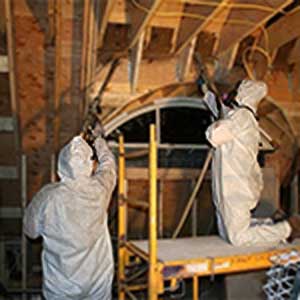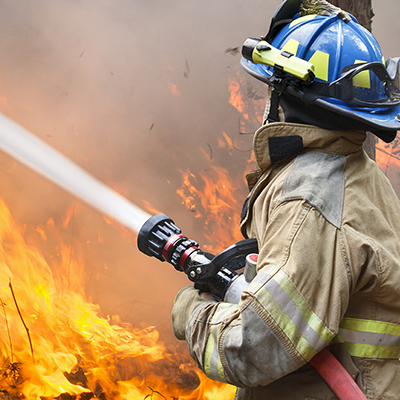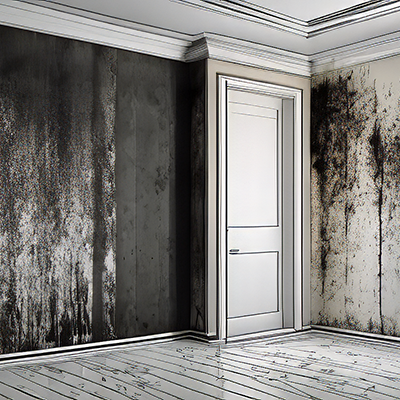
We’re here for you around the clock, ensuring that help is always within reach, especially during critical fire and flooding emergencies.

Our team’s experience spans both residential and commercial jobs, showcasing our ability to manage projects of any scale effectively.

From water damage and fire & smoke damage to air duct cleaning and biohazard cleanup, we bring your property back to its pre-disaster state.
Superior Flood & Fire is reliable and careful when they replace insulation. This can lower your heating costs and keep your family warm.
Insulation works like a barrier. It keeps heat from entering and out of your house, ensuring that conditioned warm air stays inside. Over time, insulation may get old or damaged, which can affect your HVAC system’s efficiency. This can reduce the barrier that helps your home stay at a good temperature. Because of this, you could waste energy, feel temperature changes, and end up with higher bills.
Improve Energy Efficiency with Spray Foam Insulation
Spray Foam Insulation, Blown In Insulation, and Fiberglass Insulation
Are you feeling too hot or too cold at home? Are your energy bills high because of rising costs, particularly your electric bills? It might be time to think about getting new insulation. Insulation is essential to keep your home warm and save energy. This guide will look at the benefits of changing your insulation. It will answer some questions and give helpful information to help you decide. Let’s start by seeing how better insulation can improve your home.
Types of Insulation Available
Many types of insulation are often used in buildings. Each type has its pros and cons.
Here are some common types of insulation:
- Fiberglass Insulation: This type is made from tiny glass fibers. It often comes in batts or rolls. It is not too expensive and is very common.
- Cellulose Insulation: This insulation is made from recycled paper products. It is good for the environment and can be blown into existing walls.
- Spray Foam Insulation expands to fill spaces. It has a high R-value per inch and is excellent for keeping warm or cool.
- Mineral Wool Insulation: Made from natural or recycled minerals. It can resist water and handle high heat.
- Polystyrene Insulation: There are two main types: expanded (EPS) and extruded (XPS). It resists moisture and is often used in foundations and walls.
- Reflective Insulation: Usually found in attics. It reflects heat rather than covering it.
- Radiant Barrier Insulation: Also used in attics. It reflects radiant heat and helps keep homes cooler.
Every type of insulation has its uses and benefits. The best choice depends on factors such as the climate, the kind of building, and your budget.
Also, consider a few things when choosing insulation for small spaces under the eaves in addition to the abovementioned types while keeping in mind the local climate. One option is rigid foam insulation. It can be cut to fit and keeps heat from escaping. Another option is blown-in insulation, like cellulose or fiberglass that can be installed over existing insulation. This can be easily placed in hard-to-reach spots. A professional insulation contractor can help you. They will find the best choice for your needs and install it properly.
Why Insulation Replacement Matters
Insulation acts like a shield. It keeps heat from moving between your home’s inside and outside. Over time, insulation can wear down, get damaged, or show signs of wear and not work as well. This may lead to moisture issues that may harm your home’s insulation. Because of this, you could waste energy, feel temperature changes, and have higher bills. However, putting in new insulation improves energy use and offers several benefits.
- Improved Energy Use: People often change their insulation to save energy. Old insulation allows heat to escape in winter and come in during summer, making heating and cooling systems use more energy. New insulation slows down heat flow and cuts energy use, helping to lower bills.
2. Removal of Old Insulation
You must remove your attic insulation if it is damaged, old, or not working well. You should also remove it if it is dirty. Attic insulation removal gives you a solid start for putting in new insulation. When you take it out, be careful not to let dust, dirt, or allergens spread in your home. A trained insulation worker can help with this and ensure removal is safe. It helps avoid any problems.
3. Air Sealing
Before adding new insulation, fixing any air leaks or gaps in your home is essential. Air sealing means closing up cracks and gaps in the walls, ceilings, and floors. It stops outside air from coming in, and this step helps your new insulation work better by reducing heat loss and saving energy.
4. Installation of New Insulation
Once you are set, it’s time to add the new insulation. There are several types of attic insulation: batt, blown-in, and spray foam. Your choice relies on your budget, how much insulation you need, and which parts of your home require it. A good insulation contractor can help you pick the best option for each area.
5. Quality Control and Clean-Up
After we install, we check for proper insulation and rules. Detailed checks find hidden problems. Skilled repairs improve coverage and save energy. A complete cleanup removes all signs of the old insulation. It leaves no mess behind. Your home will be tidy. You can now enjoy your new insulation.
The Importance of Replacing Insulation After a Fire
Fires can cause extensive damage to homes and belongings. In addition to this damage, people often forget about one thing: how fires harm insulation. Insulation helps keep homes cozy and saves energy. After a fire, it is important to replace the insulation to restore these important benefits.
A fire can create a lot of heat, which can cause insulation materials to break down, making it harder for them to keep the house’s temperature steady. Smoke and soot from the fire can also enter the insulation, causing a bad smell. Changing the insulation can make your home energy-efficient, comfortable, and free from bad odors.
Another reason to change insulation after a fire is the health risks. Smoke and soot have nasty chemicals and small particles in the insulation. These pollutants can hurt the lungs and lead to health problems. They are particularly dangerous for people with allergies or asthma. Replacing the insulation can create a healthier home for you and your family.
Fire damage can hurt the structure of bad insulation. The high heat can weaken the insulation or even cause it to melt. This creates holes and spaces in the coverage. These spaces can let air leak out and waste energy. Change the insulation. It will fix your home’s energy barrier and help save energy.
Risks of Not Replacing Insulation After a Fire
Not replacing insulation after a fire can cause serious issues. One problem is that your house won’t use energy efficiently. Insulation helps to keep your home warm in the winter and cool in the summer. It works by slowing down the movement of heat. This is important when you use a fireplace. If the insulation is damaged, it won’t work properly. This means your heating and cooling system will have to work harder. It will take more energy to keep your home comfortable. As a result, your energy bills will increase.
Not changing insulation after a fire carries the risk of mold growth. Water used to put out the fire can soak into the insulation. This creates a damp area where mold can thrive. Mold can lead to health issues. It might cause allergies and breathing problems. You can prevent mold and keep your home healthy by replacing the insulation.
Not changing insulation after a fire can hurt your home. Insulation helps your walls and ceilings. It keeps them steady and stops sagging. Your home might have structural issues if the insulation is weak or broken. Changing the insulation will keep your home strong and help you avoid expensive repairs.
Signs That Your Insulation Needs to Be Replaced After a Fire
After a fire, you need to look at your insulation to see if it needs to be replaced. Here are some signs that show it might need a change:
Visible damage: If insulation is exposed, flames or high heat can harm it. Look for signs like charring, melting, or breaking apart.
Odor: If your insulation has soaked in smoke and soot from a fire, it may smell bad. A strong smell shows that you need to change the insulation.
Moisture: If the insulation got wet during firefighting, it needs replacing. Wet insulation can lead to mold and reduce its ability to keep things warm.
Age: If insulation is old or almost at the end of its life, a fire can quickly make it worse. It is best to replace it to keep things working well.
If you notice any of these signs, contact a professional insulation worker. He or she can assess the problem and recommend the best steps to take.
Importance of Replacing Waterlogged Insulation
Water damage can happen when fighting fires, harming insulation. When insulation gets wet, it cannot keep heat properly. This can waste energy and make your home less comfortable. So, it is important to replace wet insulation to restore its ability to save heat.
Moist insulation can cause mold and mildew to grow. Wet areas can breed harmful germs, leading to breathing problems and allergies. Fixing wet insulation quickly stops mold and keeps your home healthy.
When you have to replace wet insulation, like rock wool, it is important to choose the right kind. There are several insulation types, each with its own advantages and disadvantages. Look at the R-value. It shows how well the insulation keeps heat, fights moisture, and resists fire. Asking an insulation expert can help you find the best option.
The Process of Replacing Insulation After Water Damage
Replacing insulation after water damage requires a clear plan. This ensures that everything is taken out properly and put back in the right way. Here is a simple overview of the steps:
Assessment: A good insulation contractor will look for any water damage. They will check for places needing new insulation and any hidden issues, like mold or damage to the structure.
Removal: The damaged insulation will be removed carefully. The team will use the right tools and methods. This step is essential to prevent more problems and to keep the area clean for new insulation.
Drying: It is key to dry the area completely before installing new insulation. This might involve using dehumidifiers, fans, or other drying methods.
Installation: The new insulation can be installed after the area is dry. The contractor will use the best materials and methods to ensure it is done correctly.
Clean-up: The area will be cleaned once the installation is done. Any trash or debris will be thrown away correctly to keep the living space clean and safe.
Understanding that the process can change depending on the situation is essential. Hiring a pro for insulation replacement makes things a lot easier.
Why It Is Necessary to Replace Insulation After Rodent Infestation
Rodents can harm your insulation badly, so you need to replace it. Rats, mice, and raccoons often make nests, chew, or dirty insulation in your attic or crawl spaces. You should replace insulation after a rodent problem for these main reasons:
- Cleanliness: Rodents can carry diseases and insects that harm people. Their droppings and urine can contaminate the insulation, making it unhealthy. Replacing the insulation can help eliminate these health dangers.
- Damage to the structure: Rodents can harm your home. They can chew through insulation and wires, weakening your house and leading to expensive repairs. It is important to replace any damaged insulation to keep your property strong.
- Removing bad smells: Rodents give off a strong, unpleasant odor. This smell can spread into your home when they nest in the insulation. Changing the insulation can help remove the smell and improve the air.
To replace insulation after a rodent issue, you need to follow several steps. First, clean the attic. Next, disinfect the area and remove any bad smells. Doing this will ensure that all signs of rodent activity are gone, and your home will be safe and healthy again.
How to Choose the Right Insulation Material for Replacement
Choosing the right insulation for your home matters a lot. It helps your house run better and saves energy. Here are some points to consider when selecting insulation:
- R-value: The R-value shows how well insulation stops heat from flowing. A higher R-value means better insulation. Think about your local weather and choose insulation with the right R-value to help save energy.
- Moisture resistance: Water can cause problems. Choose insulation that can resist moisture. Also, pick materials that soak up little water. This helps stop mold and keeps insulation working well.
- Fire resistance: Fire safety is very important, especially when replacing insulation after a fire. Select insulation with a high fire resistance rating. This will lower the risk of fire spreading and make your home safer.
- Environmental impact: Consider how insulation materials can harm the environment. Choose materials made from recycled or sustainable sources. They should release low amounts of harmful chemicals.
When you consider these factors and talk to experts, you can choose smartly and select the best insulation for your home.
Common Concerns and Questions
Replacing your insulation can be expensive, and feeling unsure or concerned is normal. We have gathered answers to common questions. This will help you find the necessary information to make an intelligent decision.
1. Will changing old blown-in insulation to batt insulation do a better job of keeping the house warm?
The choice between blown-in insulation and fiberglass batt insulation depends on several factors, including your home’s needs and the expected lifespan of the insulation. Blown-in insulation fills gaps and odd spaces better, giving more coverage. Batt insulation is easier to put in open areas and does a better job of soundproofing. Talking to an insulation expert can help you choose the best option for your home.
2. Should I be careful when moving the blown-in insulation? Could it be dangerous?
When you work with insulation, your safety is important. Blown-in insulation is safe to use. However, you should wear gloves, goggles, and a mask to help limit your contact with the insulation. It’s best to call a professional if you suspect pests or mold. They can safely remove and replace the insulation for you.
3. There are some tricky areas under the eaves where the roofline meets the attic floor. What material is best for getting good coverage in those spots?
In small spaces that are hard to reach, spray foam insulation is often the best choice. Spray foam expands and sticks to edges. It covers surfaces well and fills in gaps or cracks. It can also adapt to unusual shapes, making it great for insulating tough areas. Additionally, caulk can seal smaller gaps really well. This helps maintain the right temperature and saves energy.
4. Will the type of insulation make the house more or less dusty, or does it not matter?
The type of insulation you use does not change the dust levels in your home. The air quality influences dust, how well you ventilate your home, and how often you clean. Choosing insulation materials that block air, like spray foam, can help. It keeps dust and small particles out, improving your home’s air.
Trust the Experts at Superior Flood and Fire for Hemet Insulation Replacement
When you change insulation, it is important to choose skilled workers. They can provide good help and make sure you get great results. A trusted insulation contractor will check your needs. They will make your home’s energy efficiency more prominent. They will recommend good materials and do a clean job. When you hire experts for insulation replacement, you will enjoy several benefits. These benefits include more comfort, saving energy, and cleaner air.
Don’t let bad insulation harm your home’s comfort and function. Call Superior Flood and Fire Restoration at (951) 719-7313 for a free estimate. Our skilled team is here to provide great insulation replacement services. We will ensure your home is warm and ready for each season. Benefit from good insulation. Enjoy a cozier and energy-saving home!







